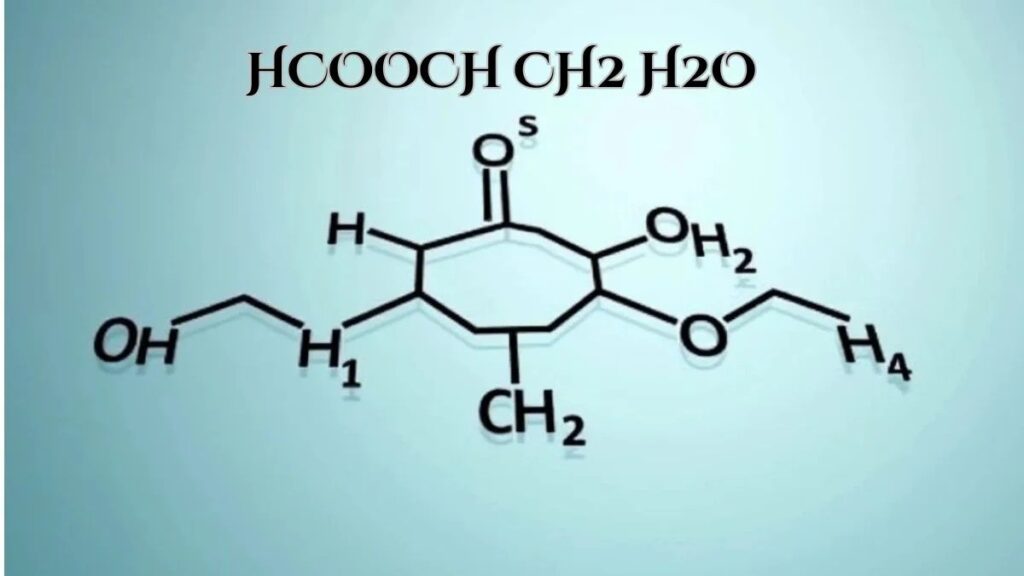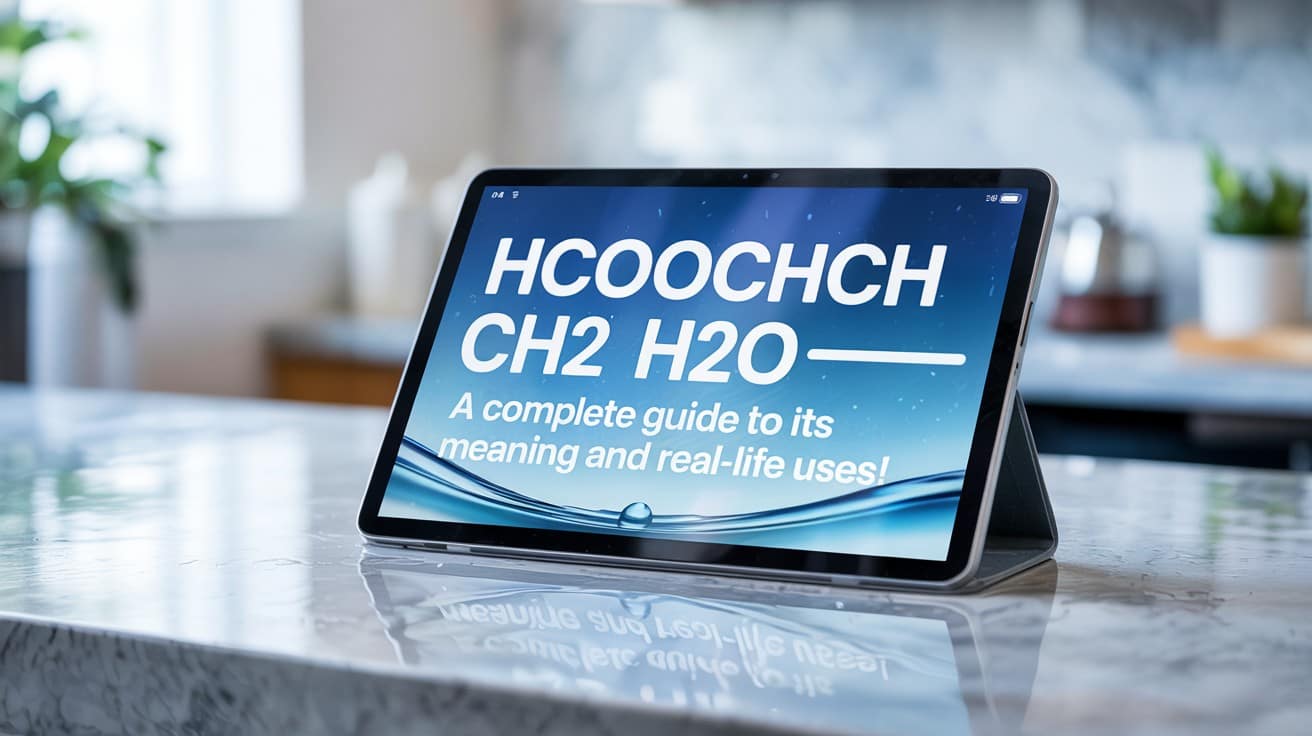hcooch ch2 h2o – A Complete Guide to Its Meaning and Real-Life Uses!
Ever seen the formula “hcooch ch2 h2o” and wondered what it means? This detailed guide breaks it down in the simplest way—no advanced science background needed. Discover what it is, how it works, and why it matters.
The formula hcooch ch2 h2o may look confusing at first, but it’s a helpful shortcut to understanding basic chemical interactions. Whether you’re a student, researcher, or just someone curious about chemistry, this article is written to be clear and simple.
What Does the Formula Stand For?
- HCOOCH: Methyl formate, an organic compound known as an ester.
- CH₂: A methylene group, a basic building block in organic molecules.
- H₂O: Water, a universal solvent and reactant in many chemical reactions.
While this formula doesn’t represent a specific single compound, it most likely describes a chemical reaction involving methyl formate, a methylene-containing compound, and water. This points to a hydrolysis reaction, which means a molecule is being broken down by water.

Breaking Down the Components
Understanding each part of the formula helps explain how it behaves in the lab or industry. Let’s look at each component in detail.
HCOOCH – What Is Methyl Formate?
Chemical name: Methyl formate
Molecular formula: HCOOCH₃ (sometimes written as HCOOCH)
Structure: Composed of a formic acid part (HCOO) and a methyl group (CH₃)
Key Characteristics:
- A colorless, flammable liquid
- Has a sweet, alcohol-like odor
- Boiling point: around 32 °C (89.6 °F)
- Easily dissolves in water and organic solvents
Uses:
- Industrial solvent (used in coatings, resins, and adhesives)
- Blowing agent for making polyurethane foams
- Chemical intermediate for pharmaceuticals and pesticides
CH₂ – The Methylene Group
The CH₂ part stands for the methylene group, which is a fragment of many organic compounds.
Properties:
- Composed of one carbon atom bonded to two hydrogen atoms
- Highly reactive in some chemical conditions
- Often acts as a bridge between other chemical groups
Importance:
- CH₂ appears in everything from fuels to plastics
- It plays a key role in polymer chemistry
- Helps link other molecules during synthesis
H₂O – Water
Water is more than just something we drink. In chemistry, it’s a vital reactant in countless reactions.
Role in Reactions:
- Helps break down or “cleave” chemical bonds
- Acts as a nucleophile (electron donor) in many organic reactions
- Often used in hydrolysis reactions, where it splits other molecules apart
hcooch ch2 h2o What Happens When HCOOCH Reacts with CH₂ and H₂O?
In organic chemistry, combinations like hcooch ch2 h2o often refer to a reaction, not just a mixture. The most logical interpretation is a hydrolysis of methyl formate, where water breaks it into methanol and formic acid.
The Reaction:
HCOOCH₃ + H₂O → HCOOH + CH₃OH
This means:
- Methyl formate reacts with water
- The ester bond is broken
- The products are formic acid (HCOOH) and methanol (CH₃OH)
Where does CH₂ fit in?
The CH₂ group could be part of another molecule or indicate that the methyl formate is attached to or reacting with a methylene-containing compound, forming a chain or more complex organic product. It’s often used to represent molecular structure rather than a separate substance.
Applications of hcooch ch2 h2o in Real Life
Let’s explore where these compounds and reactions show up in industries, labs, and even nature.
1. Industrial Use of Methyl Formate
a. Solvents
Methyl formate is widely used as a solvent in paints, coatings, adhesives, and resins. It evaporates quickly and leaves little residue.
b. Blowing Agent in Foams
It helps create polyurethane foams, which are used in furniture, mattresses, car seats, and insulation.
c. Intermediate Chemical
Used to manufacture other useful chemicals like formamide, dimethylformamide, and even some pesticides.
2. Chemical Manufacturing
Hydrolysis of methyl formate is often done on purpose to produce formic acid and methanol, both of which are useful raw materials in many industries.
3. Role in Organic Synthesis
The CH₂ group makes it possible to create longer carbon chains. This is key when designing plastics, drugs, or synthetic fibers.

Environmental Impact and Safety Concerns
When discussing chemical reactions, it’s important to look at the health and safety side as well.
Safety Profile of Methyl Formate
- Toxicity: Harmful if inhaled or ingested in large amounts
- Flammability: Highly flammable, must be stored away from heat sources
- Skin & Eye Irritation: Direct contact can cause irritation
Precautions:
- Use personal protective equipment (PPE) like gloves and goggles
- Ensure proper ventilation in labs and manufacturing settings
- Store away from direct sunlight or open flames
Environmental Effects
Methyl formate is considered low in toxicity to the environment and has zero ozone depletion potential, making it a greener alternative to older industrial solvents.
Why Does hcooch ch2 h2o Matter in Chemistry?
Even though this formula looks like random letters and numbers, it represents important principles in organic chemistry. Let’s explain why it’s valuable.
Helps Understand Organic Reactions
Understanding how water breaks down an ester gives insights into more complex organic transformations.
Supports Greener Chemistry
Using methyl formate as a solvent or reaction intermediate is less harmful to the environment than other older compounds like chlorinated solvents.
Useful for Teaching Chemistry
This formula is simple enough to introduce students to key ideas like:
- Functional groups (esters, alcohols, acids)
- Reaction types (hydrolysis)
- Carbon-based molecule building
Related Terms and Concepts You Should Know
To understand this topic even better, here are some related terms:
- Ester: A chemical compound derived from an acid and an alcohol.
- Hydrolysis: A reaction where water breaks down another compound.
- Formic Acid (HCOOH): A product of methyl formate hydrolysis; also found in ant venom.
- Methanol (CH₃OH): A simple alcohol used in fuels, solvents, and manufacturing.
- Functional Group: A specific group of atoms responsible for the characteristic reactions of a compound.
- Methylene Group (CH₂): A basic unit in many molecules, used in linking chemical chains.
Also Read: Decipher the code zpv bsf bxftpnf – A Complete Guide!
FAQs About hcooch ch2 h2o
What does “hcooch ch2 h2o” mean?
It likely refers to a reaction involving methyl formate, a methylene group, and water. The most common reaction here is hydrolysis, where methyl formate is broken down by water.
Is this a real compound or a reaction?
It’s not a single compound. It’s more like a shorthand used in chemistry to describe how certain molecules interact or are part of a reaction.
Where is this formula used in real life?
In manufacturing industries, especially those making foams, adhesives, paints, and chemicals like formic acid and methanol.
Is methyl formate safe?
Methyl formate is flammable and can be harmful if not handled properly. It should be used with proper protective gear and ventilation.
What industries rely on this reaction?
The foam industry, pharmaceutical companies, agriculture (pesticide manufacturing), and industrial chemical producers.
Conclusion
Understanding the chemistry of hcooch ch2 h2o helps build a foundation for learning about esters, hydrolysis, and the role of water in chemical reactions. This guide aimed to provide the most thorough, and beginner-friendly explanation of the topic—one that goes beyond the basics and adds real-world context and value.
Also Read: rainmakerlesses.com – A Comprehensive Guide!
conversationswithbiancas.com – A Comprehensive Guide for Parents!
skylightvoiced.com/ – Revolutionizing Communication with AI!

